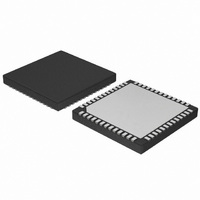AMIS49587C5872G ON Semiconductor, AMIS49587C5872G Datasheet - Page 16

AMIS49587C5872G
Manufacturer Part Number
AMIS49587C5872G
Description
IC MODEM PLC 50/60MHZ 52QFN
Manufacturer
ON Semiconductor
Datasheet
1.AMIS49587C5871RG.pdf
(55 pages)
Specifications of AMIS49587C5872G
Baud Rates
Selectable
Interface
SCI
Voltage - Supply
3 V ~ 3.6 V
Mounting Type
Surface Mount
Package / Case
52-TQFN Exposed Pad
Maximum Operating Temperature
+ 80 C
Minimum Operating Temperature
- 40 C
Modulation Type
.
Mounting Style
SMD/SMT
Operating Supply Voltage
+ 3 V to 3.6 V
Number Of Transmitters
1
Power Supply Requirement
Single
Package Type
QFN EP
Operating Temperature Classification
Commercial
Mounting
Surface Mount
Pin Count
52
Operating Temperature (min)
-40C
Dual Supply Voltage (typ)
Not RequiredV
Dual Supply Voltage (max)
Not RequiredV
Dual Supply Voltage (min)
Not RequiredV
Lead Free Status / RoHS Status
Lead free / RoHS Compliant
Data Format
-
Lead Free Status / Rohs Status
Compliant
5.1
modem dedicated to power line carrier (PLC) data
transmission on low- - or medium- -voltage power lines. The
device offers complete handling of the protocol layers from
the physical up to the MAC. AMIS- -49587 complies with
the CENELEC EN 50065- -1 and the IEC 61334- -5- -1
standards. It operates from a single 3.3 V power supply and
is interfaced to the power line by an external power driver
and transformer. An internal PLL is locked to the mains
frequency and is used to synchronize the data transmission
at data rates of 300, 600, 1200 and 2400 baud for a 50Hz
mains frequency, or 360, 720, 1440 and 2880 baud for a
60 Hz mains frequency. In both cases this corresponds to
3,6,12 or 24 data bits per half cycle of the mains period.
combines some of the advantages of a classical spread
spectrum system (e.g. immunity against narrow band
interferers) with the advantages of the classical FSK system
(low complexity). The transmitter assigns the space
frequency f
1”. The difference between S- -FSK and the classical FSK
lies in the fact that f
other, making their transmission quality independent from
each other (the strengths of the small interferences and the
signal attenuation are both independent at the two
frequencies). The frequency pairs supported by the
AMIS- -49587 are in the range of 9- -95 kHz with a typical
separation of 10 kHz.
performed at the analog front- -end of the circuit. The further
processing of the signal and the handling of the protocol is
Distribution Line Carrier (DLC) communication. It serves
two major and two minor types of applications:
•
The AMIS- -49587 is a single chip half duplex S- -FSK
S- -FSK is a modulation and demodulation technique that
The conditioning and conversion of the signal is
AMIS- -49587 intended to connect equipment using
Major types:
♦
GENERAL DESCRIPTION
A Master is a client to the data served by one or
many slaves on the power line. It collects data from
and controls the slave devices. A typical application
is a concentrator system.
Master or Client:
Application
MASTER mode
AMIS--49587 in
S
CLIENT
to “data 0” and the mark frequency f
S
and f
M
are now placed far from each
Application
AMIS--49587 in
SERVER
SLAVE mode
Major User Type
Figure 8. Application Examples
M
to “data
5 INTRODUCTION
http://onsemi.com
Application
AMIS--49587 in
SERVER
SLAVE mode
16
digital. At the back- -end side, the interface to the application
is done through a serial interface. The digital processing of
the signal is partitioned between hardwired blocks and a
microprocessor block. The microprocessor is controlled by
firmware. Where timing is most critical, the functions are
implemented with dedicated hardware. For the functions
where the timing is less critical, typically the higher level
functions, the circuit makes use of the ARM 7TDMI
microprocessor core.
handles the communication protocol. The communication
protocol, in this application, contains the MAC = Medium
Access Control Layer. The program running on the
microprocessor is stored into ROM. The working data
necessary for the processing is stored in an internal RAM.
At the back- -end side the link to the application hardware is
provided by a Serial Communication Interface (SCI). The
SCI is an easy to use serial interface, which allows
communication between an external processor used for the
application software and the AMIS- -49587 modem. The
SCI works on two wires: TXD and RXD. Baud rate is
programmed by setting 2 bits (BR0, BR1).
the AMIS- -49587 provides an innovative architectural split.
Thanks to this, the user has the benefit of a higher level
interface of the link to the PLC medium. Compared to an
interface at the physical level, the AMIS- -49587 allows
faster development of applications. The user just needs to
send the raw data to the AMIS- -49587 and no longer has to
take care of the protocol detail of the transmission over the
specific medium. This last part represents usually 50
percent of the software development costs.
•
The processor runs DSP algorithms and, at the same time,
Because the low protocol layers are handled in the circuit,
Minor type:
♦
♦
A Slave is a server of the data to the Master. A
typical application is an electricity meter equipped
with a PLC modem.
Spy or Monitor mode is used to only listen to the
data that comes across the power line. Only the
physical layer frame correctness is checked. When
Slave or Server:
Spy or Monitor:
MONITOR mode
Application
AMIS--49587 in
SPY
Minor User Type
Application
AMIS--49587 in
TEST mode
TEST










